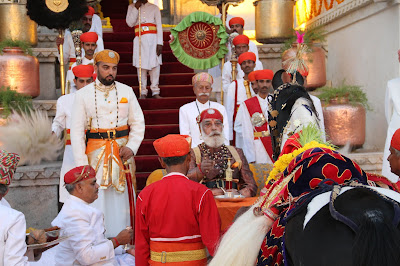The spirit of Navratri, Dusherra and Khejri Poojan overwhelms Mewar
 After that, the Maharana would mount his horse from the
Pagda ki Hatni in Manek Chowk and go with full Insignias of the state, with
entourage of nobles via Hathi Pol for Khejri Poojan, in now days Madhuban,
where there is still a vacant plot there. The place would be in a temporary
enclosure with a gate installed at the front; the Maharana would touch the top
of the gate symbolically with his sword and before entering the enclosure to
commence the Khejri Poojan.
After that, the Maharana would mount his horse from the
Pagda ki Hatni in Manek Chowk and go with full Insignias of the state, with
entourage of nobles via Hathi Pol for Khejri Poojan, in now days Madhuban,
where there is still a vacant plot there. The place would be in a temporary
enclosure with a gate installed at the front; the Maharana would touch the top
of the gate symbolically with his sword and before entering the enclosure to
commence the Khejri Poojan.
Before India’s independence on this occasion 100 or 150 guns-salutes were given, but after the merger of Mewar state into the Union of India, the gun-salutes were reduced to 21. On this occasion worshiping of the arrows with recitation of Vedic hymns was performed and they were sent through messengers to the all gate of the City to announce that the Maharana as per the auspicious time is now ready to move in any four direction for pilgrimage or any other travel.
Later the Bards would recite the traditional eulogy in presence of the Maharanas in the court for which they were given some reward. Before the court was dispersed, the Maharana would distribute betel bidas to nobles, indicating that they could now leave. The Maharana would mount his royal elephant and return to the Palace. On this occasion, a court was also held at Nahron ka Darikhana inside the Palace in Manek Chowk.
Mewar has been a devotee of various forms of Goddess Durga, also known as ‘Shakti Peeth’ from times immemorial. The House of Mewar has often made generous contributions to construct, strengthen, renovate and maintain many small temples, ‘devras’ and other places of worship of Goddess Durga. Most of these temples are owned and managed by Shree Eklingji Trust. Presently the maintenance of these temples and facilities for the devotees is being administered and performed by the Chairman and Managing Trustee of Shree Eklingji Trust, Shriji Arvind Singh Mewar of Udaipur.
2. Shree Amba Mataji, Eklingnath ji: At the Southern gate of the Shree Eklingnath ji temple of Kailashpuri is a white stone idol of Amba Mata. Located at a height, it represents a pleasant form of Ma Ambey.
3. Shree Annapurna Mataji, Udaipur: The stunning white stone idol of Shree Annapurna Mata was established by Maharana Amar Singh I in 1616 CE at the main gate (Badi Pol) of The City Palace, Udaipur. A special puja is offered to the idol for nine consecutive days during the ‘Ashwin’ month of the Hindu calendar.
4. Shree Vindhywasini Mataji, Kailashpuri: To the North of the outer boundary wall of Shree Eklingnathji temple of Kailashpuri is a Vindhyvasini temple located on an elevated platform. The Sabha Mandap of this temple boasts of eight ‘Matrikas’ (idols) which seem to belong to the 16th century. Black stone idol of Vindhywasini Mataji is an artistic marvel. A structure of ‘Kankal Bhairav’ (Skeleton) is placed on both the sides of the gate outside the sanctum of temple. The Goddess has her vehicle, ‘The Lion’, placed in front of her. This idol is worshipped post Shree Eklingnathji’s ‘Trikal Puja’. A special puja is also performed, during both the Navratras.
5. Shree Kalika Mataji, Chittorgarh: Situated on a rock in the world famous historic Fort of Chittorgarh is the Kalika Mata temple. This temple is not under the possession of Shree Eklingji Trust, however, daily worship and offering is made by the trust and Yagna is performed during both the Navratras.
6. Shree Amba Mataji, Udaipur: The main Shakti Peeth temple of Udaipur; Shree Amba Mataji was built by Maharana Raj Singh I in 1665 CE, when he brought the idol from Aarasan (Gujarat). Worshipping is held daily including both the Navratras by Shree Eklingji Trust.
7. Shree Asavra Mataji (Aavri Mata), Chittorgarh: Shree Asavara Mataji holds a prominent place among Mewar’s Shakti Peeths. Built before the 14th century, this temple is situated in Asavara village of Chittorgarh district. It bears a white stone idol of Asavara Mata, resembling the ‘Mahishasurmardini’ form. All pujas, rituals, yagnas etc. are conducted as per the ancient Vedic rules and regulations.
8. Shree Dashmukha Kalika Mataji, Shree Eklingnath ji Campus: Kalika Mata temple is one of the sub temples in the premises of Shree Eklingnathji temple. Shree Eklingji Trust sees to the upkeep of the temple and observes both the Navratras.
9. Shree Sheetla Mata Temple, Udaipur: This temple was built by Maharana Sangram Singh II in the year 1718-1719 CE near the haveli of Delwara. Hundreds of women offer prayers to Sheetla Mata on ‘Asthami’.
10. Shree Chauth Mataji, Udaipur: A shrine of Shree Chauth Mata is established in the western side of Zanana Mahal in the City Palace.
11. Shree Hast Mataji, Udaipur: Hast Mataji temple built by Maharana Karan Singh (r.1620-1628 CE) is also included in the prime Shakti Peeths of Mewar. On the seventh day of each Navratra, the Maharana would worship at this temple and sacrifice of two male goats in the name of Mataji was done.




Comments
Post a Comment